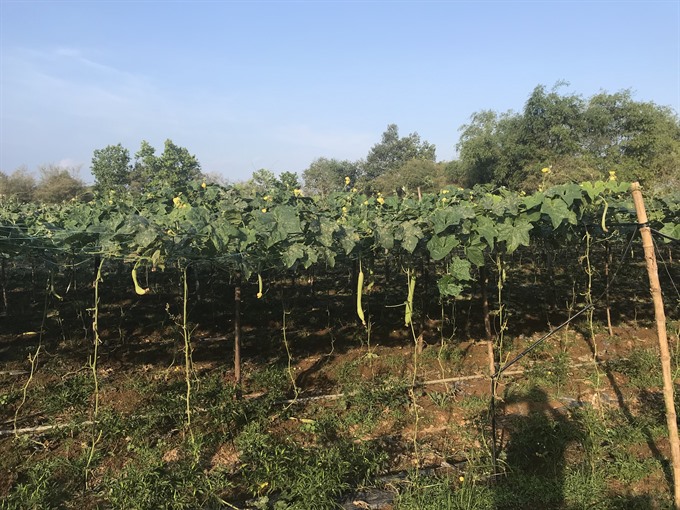 Economy
Economy

The Cửu Long (Mekong) Delta city of Trà Vinh is restructuring its agricultural sector in an effort to increase farmers’ income, especially southern Khmer farmers.
 |
| Thạch Minh, a southern Khmer farmer in Tra Vinh city, cultivates a 5-ha field of peanuts, garden asparagus, sponge gourds and capsicum. VNS Photo Văn Châu |
TRÀ VINH – The Cửu Long (Mekong) Delta city of Trà Vinh is restructuring its agricultural sector in an effort to increase farmers’ income, especially southern Khmer farmers.
The city’s Department of Agriculture and Rural Development has encouraged local farmers to cultivate other food crops instead of rice on 7,900 ha of land affected by drought and seawater intrusion caused by climate change.
The department also plans to build dykes, bridges, sluice gates, irrigation works, a clean water supply system and resident relocation areas.
Authorities have encouraged farmers to replace rice with short-term industrial plants, organic rice, coconut trees, sugarcane and fruit trees, in combination with aquaculture.
Trương Thị Ngọc Ánh, a farmer in Trà Cú District, who has shifted to other plants, said: “I and 21 households as a group invested in an irrigation dyke around rice areas to create a water supply system and to change to cultivation of organic rice. The local authorities helped us find firms that will ensure our output, offering a price that is 10 per cent higher than the market price.”
With such prices, farmers in the group have doubled their production volume and have been able to save costs for irrigation.
In the past, 1ha of rice produced only 2.5 to 4 tonnes, but after the group changed to growing organic rice and applying new technology, they harvested five to nine tonnes per ha depending on the season, she said.
Next year, the Trà Vinh City People’s Committee said it would be responsible for getting other farmers to join the small group in Trà Cú District to form a larger cooperative.
Trà Vinh City has around 234,000 ha of rice fields, producing 1.2 million tonnes per year.
Under the agricultural restructuring programme, the city plans to reduce the total rice growing areas to 224,000 ha by 2020 and 200,000 ha by 2030, according to the city’s Department of Agriculture and Rural Development.
Thạch Minh, a southern Khmer farmer, said: “I shifted 5ha of rice to peanuts, garden asparagus, sponge gourd and capsicum.”
Vegetable cultivation only needs 30 per cent of irrigation compared with rice, while the income is three time higher.
In the past, 1ha of rice brought income of about VNĐ10 million (US$450) but vegetables bring VNĐ30 million to VNĐ40 million ($1,300 – 1,800), according to Minh.
“However, I also face difficulties because I don’t have experience in growing vegetables, and lack capital to make changes,” he said.
To help farmers, the city’s Department of Agriculture and Rural Development has been working with other agencies to organise workshops and has supported low-interest bank loans, according to the city’s People’s Committee.
The targeted areas include 2,100 ha in Trà Cú District; 1,600 ha in Châu Thành District; 2,200 ha in Duyên Hải District; 730 ha in Càng Long District; 560 ha in Tiểu Cần District; 370 ha in Cầu Kè District; 350 ha in Cầu Ngang District; and 42 ha in Trà Vinh city.
Sugarcane
To encourage farmers to take part in large-scale sugarcane fields, the city’s Department of Agriculture and Rural Development has been working with Trà Vinh Sugar Company to provide sugarcane seedlings, loans and guaranteed outlets for farmers.
In the 2015-16 sugarcane season, Trà Vinh City developed the first two large-scale sugarcane fields with a total area of 46.5ha and participation of 67 households in Trà Cú District.
Huỳnh Văn Thảo, head of Trà Cú District’s Agriculture and Rural Development office, said that sugarcane grown on large-scale fields had less disease and high-yield harvests.
The city now has 27 large-scale fields with a total area of 4,230ha in the districts of Trà Cú, Châu Thành, Tiểu Cần, Cầu Ngang, Cầu Kè and Càng Long.
Thạch Sia, a southern Khmer farmer who participates in a large–scale sugarcane field in Trà Cú District’s Hàm Giang Commune, said his family had harvested 1 ha of summer-autumn rice with a yield of 140 tonnes.
This brought his family earnings of VNĐ50 million ($2,300) per season, five times higher than that of rice.
Trà Vinh City also plans to increase the area of large-scale rice fields to 9,281ha by 2020.
All large scale-rice fields will be planted under Vietnamese Good Agriculture Practices (VietGAP) standards and half of these fields will be operated by co-operatives by 2020.
The city has called on investors to develop areas to cultivate high-quality rice for export, and corn, sweet potato and other cash crops, as well as sugarcane and specialty fruits by 2020. — VNS




